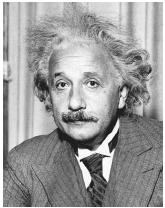Albert Einstein
GERMAN-AMERICAN PHYSICIST
1879–1955

For most people asked to name a scientist, "Albert Einstein" is the first name that comes to mind. Einstein's life story, including his difficulties with math in high school, his time spent as a patent clerk in the Swiss Patent Office, his development of the theory of relativity, and his influence on the development of the nuclear bomb, is the stuff of legends. Indeed, many a struggling high school science student has sought refuge in the notion that Einstein did not do well in that capacity either.
Einstein is perhaps best known for his work on relativity, and his simple but elegant equation E = mc 2 , which expresses an equivalence between energy and matter. It is this equation that describes the possibility of the transformation of mass into energy, and the phenomenon that is operational in a nuclear power plant or nuclear bomb. Very little matter can become an inordinate amount of energy, as the speed of light is a constant having an inordinately large value.
What is not so well known about Einstein is that he made contributions to the development of modern chemistry, particularly to the area of quantum mechanics. The Nobel Prize Committee awarded Einstein the Nobel Prize in physics in 1921 "for his services to Theoretical Physics, and especially for his discovery of the law of the photoelectric effect." His explanation of the photoelectric effect helped to validate Planck's view of quantized energy, and has become the basis of the quantitative laws of photochemistry.
The photoelectric effect had been observed as early as 1887, when the physicist Heinrich Hertz noted that light shining on metal decreased the amount of energy or voltage needed to eject electrons from the metal's surface. Further studies showed that the kinetic energy of the liberated electrons was independent of the intensity of the light; more light only produced more electrons. This kinetic energy was found to be dependent on wavelength. If the wavelength of the incident light was less than a threshold wavelength, no electrons were observed. Einstein explained the phenomenon in a paper published in the journal Annalen der Physik in 1905, the first of four papers by Einstein (all appearing in 1905) that changed science. In essence, Einstein argued that there is an intrinsic "work function" that is required to remove an electron from a metal, a specific amount of energy that depends only on the identity of the metal. The kinetic energy of the released electron is then the difference between the energy supplied by the incoming electromagnetic radiation (including visible light) and the work function. Subsequent experimental verification of Einstein's argument affirmed the claim that light was quantized.
It is one of the ironies of twentieth century science that, although his work on the photoelectric effect helped to advance quantum mechanics, Einstein came to be its chief critic. It was his antagonism toward the probabilistic and nondeterministic nature of quantum phenomena that prompted Einstein to make the often-quoted remark, "I cannot believe that God would choose to play dice with the universe."
Einstein's explanation of the photoelectric effect was not his only contribution to chemistry. His Ph.D. dissertation, submitted in 1905, was entitled "A New Determination of Molecular Dimensions." His investigation of Brownian motion (the random movement of microscopic particles suspended in liquids or gases) was intended to establish the existence of atoms as being indispensable to an explanation of the molecular-kinetic theory of heat. And the concept of relativity has shed light on the motions of electrons in the core orbitals of heavy elements.
SEE ALSO Quantum Chemistry .
Todd W. Whitcombe
Bibliography
Pais, Abraham (1982). Subtle Is the Lord: The Science and Life of Albert Einstein. New York: Oxford University Press.
Stachel, John J., ed. (1998). Einstein's Miraculous Year: Five Papers that Changed the Face of Physics. Princeton, NJ: Princeton University Press.
Internet Resources
Friedman, S. Morgan. "Albert Einstein Online." Available from http://www.westegg.com/einstein/ .
Nobel e-Museum. "Albert Einstein—Biography." Available from http://www.nobel.se .